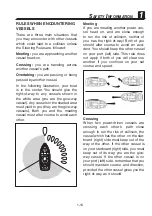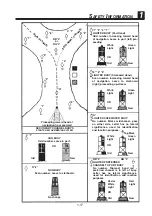
#
S
AFETY
I
NFORMATION
1-8
REQUIRED EQUIPMENT
The U.S. Coast Guard (USCG) has
regulations which describe minimum
standards of safety. You must comply
with these regulations, which apply to
boats like your boat which are less than
26 feet long.
•
Personal Flotation Devices (PFDs):
USCG-approved PFDs worn by all
people aboard, plus at least one
Type IV (throwable type).
•
Fire Extinguisher:
At least one B-1 type hand-held por-
table fire extinguisher.
•
Visual Distress Signals:
It is recommended that a USCG-
approved pyrotechnic device be
stored on your boat. A mirror can also
be used as an emergency signal.
Contact your Yamaha dealer or the
Coast Guard for more information.
•
Sound Signalling Device:
Your boat is equipped with a horn
that can be used to signal other
boats. See “Rules of the Road” for
more information.
•
Navigation Lights:
Your boat is equipped with naviga-
tion lights for use between sunset
and sunrise, and during periods of
reduced visibility, such as fog. Be
sure these lights are working and
are turned on when necessary (see
page 2-14 and 3-9 for more informa-
tion).
ADDITIONAL EQUIPMENT
RECOMMENDATIONS
The following equipment can help
make your boating experience safer
and more enjoyable:
•
Mooring fenders and lines.
•
Anchor with suitable line (a
“Danforth” type anchor and line that
is at least 6-times the depth of the
water where you will drop anchor
are recommended).
•
Manual-type bilge pump.
•
First Aid kit.
•
Waterproof flashlight with extra bat-
teries.
•
Tool kit with assorted screwdrivers,
pliers, wrenches (including metric
sizes), and electrical tape.
•
Oar or paddle (look for one with a
boat hook on the other end).
•
Spare parts, such as an extra set of
fuses.
•
Navigation charts for the waters
where you will be boating.
•
Tow rope.
1
















































